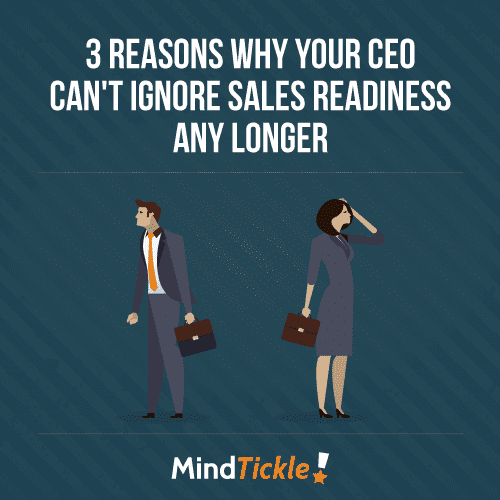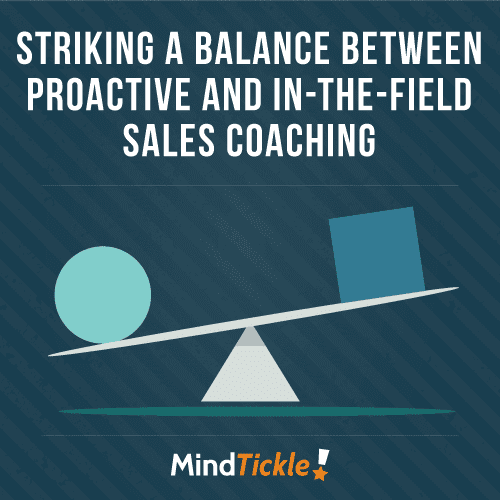3 Reasons why your CEO Can’t Ignore Sales Readiness any Longer
have a sales enablement or sales readiness function. This is the area that is responsible not only for sales training but ensuring reps are coached, receive appropriate reinforcement and have all the tools they need at their disposal. According to research by the ATD, continuous investment in training and reinforcement activities, like coaching, with sales reps results in over 50% higher net sales per employee. This translates into a 40% higher gross profit per employee and 20% higher ratio of market-to-book value.
Now mentally calculate what a difference those achievements would make to your bottom line and your shareholder value. It’s a compelling case for sale readiness, but how do you convince your CEO?
Here are three reasons why your CEO can’t ignore sales readiness any longer.
Give them context: Disruption is the new normal
The C-Suite can no longer just set a strategy and watch it being implemented over the next 6 to 12 months. Every industry is changing rapidly and all hands are required on deck to ensure your business doesn’t fall victim to the next disruptor.
According to Eugene Clerk of Credit Suisse
, the average age of a company listed on the S&P 500 has fallen from 60 years old in the 1950s to less than 20 years old today.
That means the company that is getting ready to disrupt your business may not even exist yet.
With so much change occurring, your frontline teams need to have direct alignment with leadership. Whether your business is just tweaking strategy or pivoting, your sales reps need to be able to deliver the vision as soon as you make a change. Otherwise, thanks to the wonders of the internet, you risk your customers and competitors being more up-to-date than your sales reps.
That’s why your CEO needs a direct line to the frontline teams, so they can change their messaging quickly.
Most companies tweak or change their messaging regularly, to keep up with competitive changes and new product updates. A lot of time and effort goes into each change, especially if it involves a new product rollout. Given that anywhere
between 33% and 80% of new products
fail, and each can cost millions of dollars, it’s worth taking the time to try and get it right. According to Harvard research, the
biggest reason new products fail is lack of preparation.
A lot of resources are devoted to designing the product, but the finer details of the launch are forgotten, like preparing your sales team to sell it.
Add on top of that, the cost and lost sales that you’ll incur by taking your reps out of the field to attend classroom training each time you roll out a new feature, and it builds a compelling case to find a sales readiness solution that works.
Reps belong on-the-field, that’s why sales readiness technology is crucial now. It enables your reps to cope with constant change while they’re on the field.
2. To grow shareholder value you need to measure effectiveness as well as efficiency
In order to maximize your shareholder value, you can’t just deliver some training to your sales reps and cross your fingers. Your business needs to be able to measure what knowledge has been transferred and quantify how much topline revenue it will generate.
Quantifying results has traditionally been easy to do with tools that profess to improve the efficiency of your sales team. Automatic diallers and emails, and a vast array of other selling tools have all helped your sales organization achieve more with the same amount of resources. But when it comes to effectiveness, you need to be able to demonstrate the ROI to your shareholders.
One way that you can measure the revenue impact of efficiency initiatives on your sales organization is by tracking if they are achieving larger deal sizes and increasing their win rates, for example. Sales readiness tools help reps improve these metrics by improving how effective they are at selling.
Research by CSO Insights
looked at how win rates increased after reps received appropriate training on social selling. They found that training that met or exceeded expectations also improved win rates by 38% and improved quota attainment by 51%. Then a
dd on top of that the impact of effective sales coaching, that can see
win rates increase from 25% to 54%
over 18 months.
But for a sales coaching program to be effective, it needs to be systematic. Sales leaders can use sales readiness tools to identify what reps need to be coached on, and leverage tried and tested programs to coach their reps. Overlay individual sales performance before and after coaching, and you can predict what the longer-term impact on your revenue will be.
Of course, if you’re scaling it may also be necessary to hire more reps, to cover broader markets and industries as well. However, hiring 10x more reps is unlikely to translate into 10x revenue. That’s because new reps need time and skills to ramp up and become productive. Depending on your product and market this can take 6 months or more. That means your bottom line will take a hit while your top line remains flat, placing your ambitious expansion plans in jeopardy.
Sales readiness tools are also designed to onboard and ramp up your new hires quickly. They give managers and sales enablement leaders the tools to identify and nip any problems in the bud and work out how to get each individual new hire to productivity as soon as possible. The quicker they’re onboard, the more shareholder value they will generate.
Research by Aberdeen has found that 34%
more new hires achieve quota after receiving reinforcement for their training. When you consider that the average B2B sales rep costs $29,000 to hire and takes 7.3 months to achieve full productivity, anything you can do to bring that down will have an immediate impact on your top (and bottom) line.
Sales management can predict the impact of these initiatives on your bottom line by measuring how much quicker new hires are becoming productive – time to first sale or time to achieving quota, for example. If all your reps achieve their quota a couple of months earlier, that’s two months worth of revenue that goes straight to your top line.
3. Show the long-term value of your investments
The C-Suite rarely gets into the minutiae of sales initiatives. For example, they might see some glossy publications and a rather hefty cost centre, but do they know what the return on these investments really is?
To make decisions on where to allocate resources they need to see the bigger picture. What economic impact will sales readiness initiatives collectively have over the course of the year?
Take collateral for an example.
Research indicates
that between 70% to 80% of collateral is never used. That’s a huge sunk cost, but it doesn’t mean that the content isn’t valuable. Rather than just cutting the budget, show the C-Suite how much more value this investment can create if you enable your reps.
According to SiriusDecisions, one of the reasons 63% of sales reps fail to achieve quota is because they can’t find and use the relevant content. Now if sales readiness tools can enable your reps to use collateral to their advantage, those reps who aren’t making quota can potentially improve their performance. A simple calculation can show you just how much of an impact that can potentially have over the course of an entire year.
Now extrapolate that over the course of every single product launch or new feature that you release. If sales readiness tools can improve how your reps sell each new product and feature, how much more will you sell each year?
It’s a compelling argument that your CEO will find difficult to ignore. Then the question doesn’t become whether you should invest in sales readiness, it’s why haven’t you invested in it yet?







